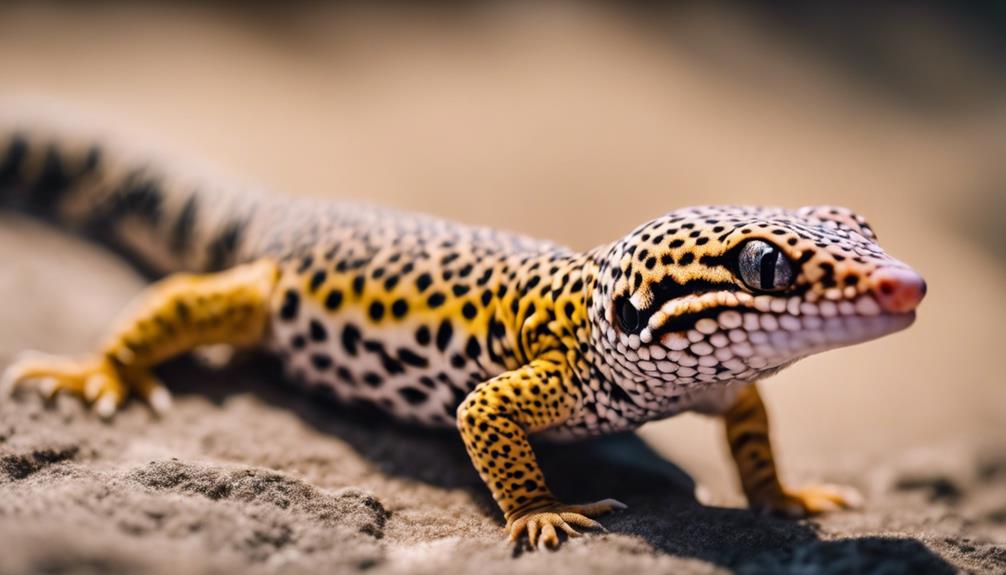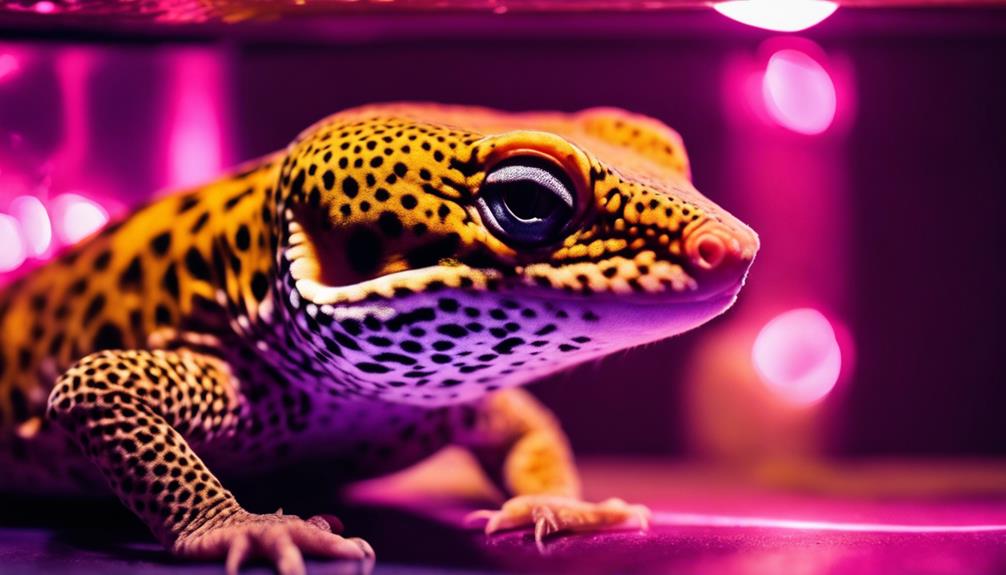If you've ever wondered what causes Leopard Geckos to be patternless, the answer lies in a fascinating genetic mutation called Murphy Patternless.
This unique trait, discovered by Pat Murphy in 1991, results in geckos devoid of any patterns, with their markings gradually fading as they mature.
However, the mystery doesn't stop there. Stay tuned to uncover the intricate interplay between genetics, morphological features, and breeding methods that contribute to the mesmerizing patternless appearance of these geckos.
Key Takeaways
- Patternless trait in leopard geckos is a simple recessive mutation identified by Pat Murphy in 1991.
- Genetic inheritance follows a predictable pattern, with controlled breeding strategies crucial for maintaining desired traits.
- Environmental factors do not influence the development of patternless traits in leopard geckos.
- Selective breeding over generations enhances the expression of patternless traits in geckos.
Genetic Basis of Patternless Leopard Geckos
The genetic basis of patternless Leopard Geckos stems from a simple recessive mutation identified by Pat Murphy in 1991. This genetic mutation is inherited in a critical manner, where offspring of a Murphy Patternless Gecko crossed with a Normal Gecko are heterozygous for the trait.
When two heterozygous geckos are bred, there's a 25% chance of producing a Murphy Patternless Gecko due to the Mendelian inheritance pattern governing this trait. Over the past two decades, researchers have extensively studied the genetic diversity present in these geckos, particularly in the context of captive breeding programs.
Maintaining genetic diversity is essential not only for the preservation of the Murphy Patternless trait but also for studying the variations that exist within this unique genetic mutation. By understanding the genetic underpinnings of patternless Leopard Geckos, breeders can make informed decisions to ensure the health and diversity of these intriguing reptiles in captivity.
Role of Morphological Traits
Examine the intricate relationship between morphological traits and the genetic mutation responsible for the patternless phenotype in Leopard Geckos. Patternless Geckos exhibit a light-colored body adorned with random markings that gradually fade over time, contributing to their unique appearance. These morphological traits are a direct result of the specific genetic mutation identified in 1991. Through selective breeding and careful consideration of genetic inheritance, breeders have maintained the distinct characteristics of Patternless Geckos, making the continuation of their striking features. The body colors of Patternless Geckos range from vibrant yellows to deep purples, further enhancing their visual appeal and making them highly sought after in the reptile community.
| Morphological Traits | Description | Importance |
|---|---|---|
| Light-Colored Body | Mainly light hues | Provides a canvas for random markings |
| Random Markings | Unique patterns scattered across body | Contribute to individuality |
| Fading Over Time | Markings gradually diminish | Adds intrigue to gecko's appearance |
| Selective Breeding | Controlled mating for desired traits | Ensures consistency in future offspring |
Understanding Pattern Variation
Understanding the intricate variations in patterns among Leopard Geckos is important for discerning the genetic underpinnings of their unique appearances. Patternless Leopard Geckos exhibit a lack of traditional markings, with these patterns typically fading by the age of 10 months, resulting in a solid-colored body that can range from hues of yellow to deep purple.
The genetic inheritance of the Patternless trait follows a simple recessive pattern, requiring specific breeding strategies to maintain this desired characteristic. By carefully selecting breeding pairs based on their genetic makeup, breeders can enhance the likelihood of producing Patternless offspring. Additionally, cross-breeding with other morphs such as albinos or Blizzards can lead to visually striking variations within the Patternless Leopard Gecko population, offering a wide array of colors and patterns for enthusiasts to enjoy.
Understanding the nuances of pattern variation in Leopard Geckos not only aids in appreciating their aesthetic diversity but also contributes to the advancement of breeding practices within the reptile community.
Breeding Strategies for Patternless Geckos
For those aiming to propagate the Patternless trait in Leopard Geckos, strategic breeding combinations involving Murphy Patternless and normal geckos are essential. By pairing a Murphy Patternless Leopard gecko with a normal one, you can produce heterozygous offspring. These heterozygous geckos have a 25% chance of displaying the desired Murphy Patternless trait. To increase the odds, breeding two heterozygous geckos results in a 66.7% chance of producing more heterozygous offspring, furthering the chances of obtaining Patternless geckos.
Understanding the specific genetic inheritance patterns involved is vital in determining the likelihood of obtaining Murphy Patternless geckos. In some cases, test breeding may be necessary to confirm homozygous traits, especially in geckos like Blizzard and Murphy Patternless, where the visual distinction may not be apparent. Through careful breeding practices and a thorough understanding of genetic inheritance, you can increase the chances of successfully propagating the Patternless trait in Leopard Geckos.
Environmental Influences on Patterns
Leopard gecko patterns are mainly influenced by genetic mutations rather than environmental factors. The development of patternless traits in leopard geckos isn't directly impacted by environmental influences. Instead, these unique characteristics arise from specific genetic mutations that have been selectively bred over generations. Through careful breeding strategies, breeders can enhance the expression of patternless traits in leopard geckos, leading to a distinct and striking appearance.
Unlike some traits that may be influenced by environmental factors, the patternless trait in leopard geckos remains consistent regardless of external conditions. This stability further supports the notion that genetic mutations play a primary role in determining the appearance of these geckos. By focusing on selective breeding and genetic variation, breeders can continue to refine and emphasize the patternless characteristics in leopard geckos, creating specimens that exhibit a remarkable and consistent lack of patterns.
Frequently Asked Questions
What Is a Patternless Leopard Gecko?
A patternless leopard gecko is one without any visible markings on its body. This unique trait is not due to environmental factors but rather a genetic mutation resulting from selective breeding efforts. Skin pigmentation, scale texture, and breeding patterns contribute to this distinct appearance.
Do Leopard Geckos Change Patterns?
As leopard geckos age, their patterns evolve, like a painter adding layers to a canvas. Changing colors, growth stages, breeding practices, and environmental factors influence these shifts. Genetic mutations, diet, health, and temperature also play roles.
What Leopard Gecko Morphs Have No Spots?
When exploring spotless gecko varieties, consider genetic mutations, color variation, breeding techniques, skin pigmentation, spot reduction, spotted gene, and pattern elimination. The absence of spots in certain morphs showcases intricate genetic interactions and selective breeding strategies.
What Makes Leopard Geckos Unique?
In a league of their own, Leopard Geckos stand out for their vibrant color variations, striking tail length, mesmerizing eye color, unique scale texture, behavior differences, and specific habitat preferences, diet variations, and temperature tolerance.
Conclusion
You now grasp the intricate genetic foundation behind the mesmerizing patternless appearance of leopard geckos. By delving into the role of morphological traits and understanding pattern variation, you have uncovered the secrets of breeding strategies for producing these unique geckos.
Remember, environmental influences also play a critical role in shaping the patterns of these fascinating creatures. Embrace the complexity and beauty of nature's creations as you continue your exploration into the world of leopard geckos.


